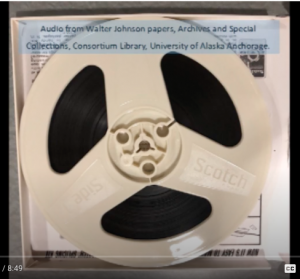Hello there, all you cool archivists and researchers! This is Becky Butler here to tell you about my experience working on the digitization project made possible by the Council on Library and Information Resources and funded by the Andrew W. Mellon Foundation. You can learn more about the project in this other blog post, but essentially, another archivist identified collections related to public health with obsolete or difficult-to-use A/V materials. We sent those materials to be digitized by an outside company, then I described them and posted as many of the materials online as possible. It’s quite a bit of background work, so I thought I’d walk you through my experience.
Archivists get asked “Why don’t you just put everything online?” very frequently. Short answer: we’d love to, but it’s a lot of work. Long answer: not everything is appropriate to put online for legal or cultural reasons, even digital storage requires backups and checksums to truly archive, and adding metadata so that items are discoverable to researchers and search engines is incredibly time-consuming. I never truly appreciated that final point until I worked on this project.
For starters, after we received digital files back from the digitization company, I spot-checked every video and audio clip to determine its content. That means I viewed or listened to it every 5-10 minutes to determine its content. I then wrote up a brief description, decided if it could go online or not, added citation information if so, and posted it on Alaska’s Digital Archives and/or Youtube. Each of those sites has its own way of assigning keywords, titles, creators, dates, and a plethora of other bits of information that make it possible for people to find the content. While I could reuse some descriptors, I still had to input those descriptors individually into each site. A three-hour video could then take me at least an hour to check, describe, and post.

Here’s an example of some of the metadata I added for each item I uploaded to Alaska’s Digital Archives
Here’s another tricky point about the time it takes to digitize — you don’t always know if it will be worth it until it’s done. Some of the formats we digitized were decades out of date. It’s not like you can pop a dictabelt into your smart TV to find out what it says! Some of the content I reviewed turned out to be poor quality, recorded from the radio, or simply people testing their recording equipment. Since these items were usually unlabeled or mislabeled, there was no way to know that until we had the digital versions. I also still needed to spot-check them to discover they weren’t relevant to our public health theme. Fortunately for this project, we didn’t have too many off-topic materials, but that’s always a risk when you take on a digitization project for old format materials.

Would you know how to play this audio reel?
All in all, I’m very pleased to have worked on the CLIR project. I learned how to better manage my time so I could describe more materials in less time, how to assign keywords to accurately describe materials’ content, and how to use multiple new pieces of software. I’m so very hopeful my work enables researchers to learn more about public health history in Alaska! Check out the end result of the project here, listen to the podcast episode where I discuss my experience in more depth, and let us know if you have any questions about using the materials.


